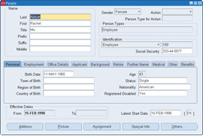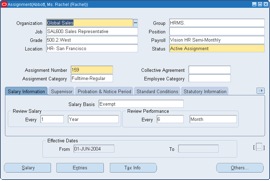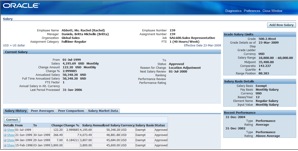Oracle Human Resources
Oracle Human Resources extends human resources capabilities with “localizations”— extensions of software that expand core functionality to include country-specific requirements. Oracle Human Resources supports a complete set of country-specific functionality, including legislative HR data, for more than 28 countries.
For a business to function under global HR practices and procedures, its HR-related applications must be flexible enough to accommodate policies that may differ across business units and between countries around the world. Oracle Human Resources supports local business practices and legal requirements and manages business-critical operations across borders.
Human Resources departments routinely face the challenge of ensuring compliance with laws and mandates throughout the world. Oracle Human Resources offers the best of both worlds within one installation. It delivers a foundation consisting of non-legislative information common across all countries, as well as fully localized data specific to each country, including legislative data, reporting guidelines, business rules, process requirements, data entry forms standards, and online help in the appropriate languages.
Oracle Human Resources also helps businesses establish and amend policies through a unique, flexible, and rules-based engine. For example, rules-based payroll accommodates adjustments to reward employees for outstanding achievements and provides rapid implementation of bargaining agreements and global tax structures.
Oracle Human Resources enables firms to track all HR-related data elements required by the business, including regulatory data. Managing the organizational structure requires establishing reporting relationships and various grouping entities (for example, region, division, department, team), extending down to the individual position for some industry segments.
Job information (including skill and competency requirements) is critical to other strategic phases, and it forms the foundation for many compliance activities. In addition, tracking worker demographic and employment data is also an essential component. It is important to note that core data management processes have recently expanded to include various types of contingent workers (for example, contractors, temporary employees, interns), so that your organization can get a complete picture of who is doing what work, and where.



